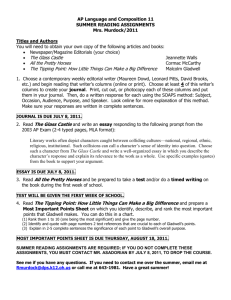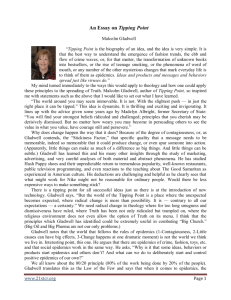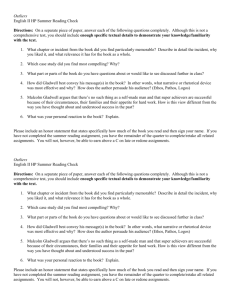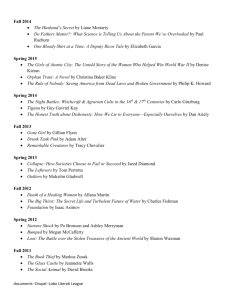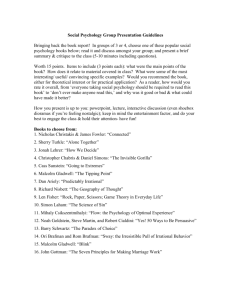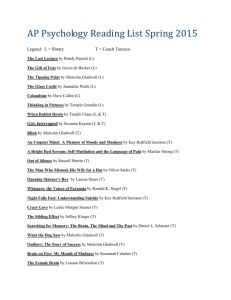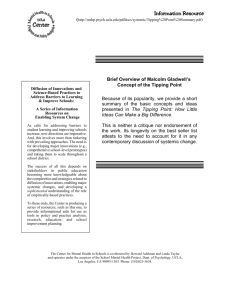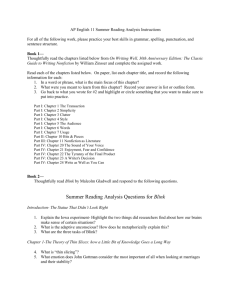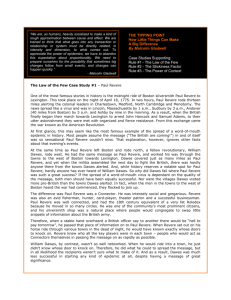The Tipping Point - Time-Management
advertisement
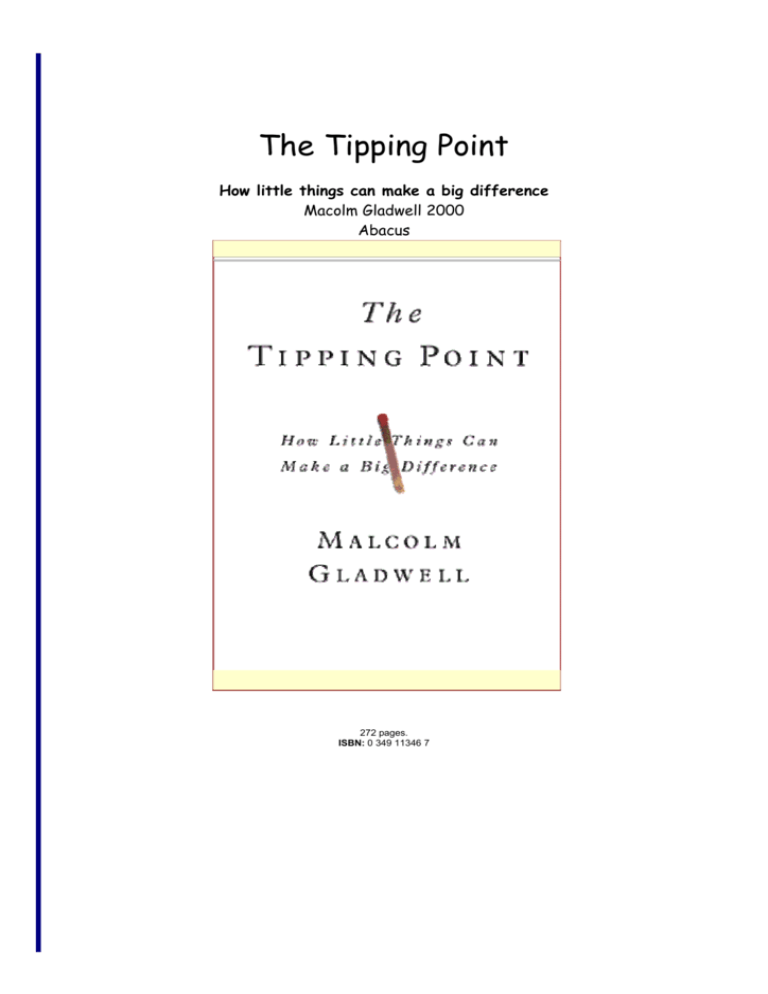
The Tipping Point How little things can make a big difference Macolm Gladwell 2000 Abacus 272 pages. ISBN: 0 349 11346 7 The Tipping Point, Malcolm Gladwell, 2000 The Big Picture The Tipping Point is an idea that helps us understand the emergence of fashion trends, the ebb and flow of crime, the transformation of unknown books in to best sellers and many other mysterious changes that happen. The best way to think about them is in terms of the spread of epidemics. Ideas, products, messages and behaviours spread like viruses! The Tipping Point theory says that little things have a big impact. characteristics are: Contagiousness – how a “trend” spreads Little changes have big effects Change happens in one dramatic moment The three key This dramatic moment is “The Tipping Point”. Gladwell frames the theory around the spread of epidemics. He then uses many examples from Sesame Street to smoking, Hush Puppies to Crime in New York to provide evidence that “The Tipping Point” is a valid way to understand and even produce a social epidemic. The concept of “The Tipping Point” requires a change in our thinking. It challenges us to see things outside the comfort of our comfortable environment. It says to us that perhaps small things we do CAN make a difference on a big scale. Page 2 of 9 time@time-management-central.net ------- © http://www.time-management-central.net 2003 ------- The Tipping Point, Malcolm Gladwell, 2000 Chapter 1 – 3 Rules of Epidemics Gladwell uses examples of how several disease epidemics “tipped” to introduce the the three rules of epidemics. In the mid 1990s Baltimore had an epidemic of syphilis. There were several theories as to what tipped the epidemic. One related to an increase in the use of the drug crack. Another related to the reduction of sexually transmitted disease clinics (and visits). A third related to changes in housing, causing people to move home. The interesting thing here is that none if the theories involved a dramatic change. These three theories also refer to three different ways of tipping an epidemic. The first relates to the context – how the growth in use of a drug can change the city environment causing a disease to tip. The second relates to the disease itself and how it could spread more easily if not treated. The third focuses on the people carrying the disease – how if key people moved to a new part of town, the disease could be tipped. When an epidemic tips it is because one or more of these factors have changed enough to tip the equilibrium. Gladwell calls these these change agents: The law of the few The stickiness factor The power of context These three rules offer a way of making sense of epidemics and possibly a framework for how to go about reaching a tipping point. Chapter 2 – The Law of the Few The Law of the Few says that there are a small number of key people that are responsible for spreading a “trend”. Connectors A connector is a person who knows lots of other people – usually 2 to 10 times more than the average person. They are social people and think it is “normal” to keep in contact with so any people and groups. They can be thought of as social glue. In networking terms (as described by Granovetter) connectors are the master of “weak ties” – that is they consistently interact with what we might call acquaintances. Example – Paul Revere and William Dawes. Gladwell uses this example to explain what a connector is. The story goes that Revere and Dawes spread the same message at about the same time in different parts of country. Why has Paul Revere’s ride and statement “the British are coming” gone down in history, yet Dawes has never been heard of? Well Revere is what Gladwell calls a connector. Revere knew which people to communicate his message to. These people also knew of Revere and respected him, therefore they listened to his message. Mavens Page 3 of 9 time@time-management-central.net ------- © http://www.time-management-central.net 2003 ------- The Tipping Point, Malcolm Gladwell, 2000 Mavens are people who love accumulate knowledge and pass it on to help others. They are the people who always know where to get the best deals. They are socially motivated and actually meet their own emotional needs by helping others solve problems. They are students first and then educators. They can be thought of a human “data bank” Salespeople Salesman are people who have an inbuilt ability to persuade and generate enthusiasm in others. They love being with and helping people. They are passionate in everything they do. They have charm and are very likeable. Their genuineness comes through in their communication. They have a subtle way of mirroring others body language, but it is a natural thing they do without thinking. Gladwell describes this as a super-reflex. Connectors, Mavens and Salesman enable innovations to move from a good idea that is used by people who thrive on “newness” to a mainstream product accepted by a significant portion of the community. Chapter 3 – The Stickiness Factor Stickiness refers to the impact of a message. Does the message stick in your head or go in one ear and out the other. Gladwell goes in to detail about the stickiness of Sesame Street and Blues Clues. Sesame Street head of research, Ed Palmer, created a way of determining whether an episode was “sticky”, which they called the “distractor”. He ran a series of slides at the same time the Sesame Street episode was running and noted whether the children watched the slide show or Sesame Street. Blues Clues came on the scene in 1996 and within months it was beating Sesame Street. The Blues Clues format is totally different to Sesame Street and is based around the “James Earl Jones effect” – learning through repetition. Sesame Streets focus on being “clever” and the desire to entertain adults too, actually reduced stickiness for pre-schoolers. Blues Clues found that repetition is very valuable for young kids – in fact they demand it. Lester Wunderman’s Gold Box advertising campaign is another great example. Wunderman went head to head with McCann in the 1970s to see who would win the contract to provide all the advertising. Wundermann suggested they run both campaigns (in separate local markets segments) and the one that had the greatest impact would get the contract. Wunderman won as his markets were up 80% compared to 19.5% for McCann. The reason is attributed to the “Gold Box”. Wundermann placed a gold box in every ad and in each TV commercial viewers were told they could if they could find the gold box they could write to Columbia and select a free record from a list. The gold box gave viewers a reason to go looking for the ads in the TV Guide. The “treasure hunt” had made viewers participants, according to Wunderman. In 1977 none of Columbia’s ads in its extensive magazine schedule had been profitable. In 1978, with gold box television support, every magazine on the schedule made a profit. In another experiment in the 1960s an educational message was made “more sticky” by adding seemingly unimportant information. Howard Leventhal wanted to see if he could persuade college students to get a tetanus shot. Different versions of an educational booklet were produced called “high fear” and “low fear”, based on how dramatic tetanus Page 4 of 9 time@time-management-central.net ------- © http://www.time-management-central.net 2003 ------- The Tipping Point, Malcolm Gladwell, 2000 was described. One month later only 3% had actually got the injections, even though they had demonstrated they understood the material and the importance of getting shots. Leventhal re-did the experiment adding only a map of the campus with the health building circled and the times the shots were available. The percentage of student that got the shots went up to 28%! The type of booklet they were given didn’t have a significant impact. Interestingly, as the students had been at the college several years they must have known where the health building was. Adding the map and the times made the information practical and personal. Given the huge “clutter” of advertising today, perhaps we have a lot to learn from Wunderman and Leventhal. That is that there maybe simple ways to enhance “stickness”. The key message is that there is a simple way to package an idea and it is the small details that can make all the difference. Chapters 4 and 5 – The Power of Context Context is about the environment or perspective from which we see things. Gladwell suggests we are very sensitive to the environment and small changes, in certain circumstances, have a big impact. In the mid-1980s James Q Wilson and George Kelling espoused a “Broken Window” theory that basically said crime is the result of disorder. If a window is left unrepaired, people assume no-one cares or is in-charge, so more damage will be done. Kelling was hired by the New York Transit Authority as a consultant and convinced them to put the theory in to practice. David Gunn, the new subway director, was overseeing a multi-billion dollar refurbishment of the subway. Although many suggested Gunn focus on “bigger” things than graffiti, he insisted it was symbolic of the collapse of the system. The plan was implemented and graffiti was removed as soon as it was completed (it took the kids three days to “create” it). The transit police chief William Bratton, believed in the theory and applied it to fair evaders. As many as 10 plain-clothes police would nab the fare evaders and handcuff them to a rail. One out of seven fair evaders turned out to have an outstanding warrant! This was applied to the “street” (‘if you peed in the street you were going to jail’ said Bratton) and the crime rate went down. Minor, seemingly insignificant things were the tipping points for violent crime. The Power of Context suggests what matters is little things. It says you don’t have to solve big problems to solve crime. This is a radical theory and the implications are enormous. It suggests environmental tipping points are things we can change! In the 1970s Phillip Zimbardo decide to create a mock prison scenario to try and find out why prisons where such nasty places. Was it because of the people or the environment? The most normal and healthy on psychological tests were selected. Half were chosen, at random to be guards, the rest prisoners. Within days the guards, some of whom had identified themselves as pacifists, took on the role. They began dealing out physical punishment and being abusive. They employed behaviour they said they would never normally do! On the second day the prisoners rebelled. The experiment had to be stopped. The conclusion Zimbardo made was that the “situation” (context) can overwhelm Page 5 of 9 time@time-management-central.net ------- © http://www.time-management-central.net 2003 ------- The Tipping Point, Malcolm Gladwell, 2000 our inherent predispositions. Even more challenging is the concept that what we consider our normal behaviour is only normal in our normal environment! Fundamental attribution error (FAE) is a fancy word Psychologists use to say that when it comes to interpret other people’s behaviour, humans make the mistake of overestimating character and underestimating situation and context. Gladwell argues that character is more like a bundle of habits and tendencies, loosely entwined and often dependent on the situation and context. John Darley and Daniel Batson, two University psychologists conducted a study inspired by the story of the Good Samaritan. To summarise the findings in a sentence – the statement “you’re late” led to ministry students stepping over a person in need. This suggests that convictions of your heart are less important than the immediate context of your behaviour. In a real life example, Divine Secrets of the Ya Ya Sisterhood sold slowly initially – only to become a best seller over two years after launch. The book is “sticky” and Rebecca Wells is a natural salesmen. What happened in the two years from launch (and slow sales ) to a best seller? Gladwell suggests it was the Power of Context and the critical role groups play in social epidemics that “tipped” the book on to the best seller list. The Divine secrets of the Ya Ya sisterhood turned out to be the ultimate “book group book”. Word spread like wild fire from reading group to reading group. So this begs the question – what are the most effective types of groups? This is answered by the Rule of 150. The rule of 150 says, in simple terms, that when groups get larger than 150, people become strangers to one another. You end up with 2 or 3 groups within the larger group. This means there is impediments to the group acting with one voice. The Gore organisation (possible best known for Gore-Tex waterproof fabric). Operates under this principle. At Gore everyone is an “associate” (no titles). People have sponsors (not bosses) and there are no organisational charts, budgets or elaborate strategic plans. Gore achieves great results with this approach by following the rule of 150. They try to split groups in to smaller and smaller semi-autonomous pieces. The advantage is that every part of a Gore group process for designing, making and marketing a product is subject to the same group scrutiny. The paradox of the epidemic is that to create one contagious movement you often have to create many small movements first. Chapters 6 & 7 – Case Studies Airwalk sneakers Their advertising used the principles of academic transmission. The ads themselves actually helped tip the trend through identifying “innovators”. “It’s all about timing” said Chad Farmer of Lambesis advertising agency. But, Airwalk admits they got greedy. The product was no longer cool because it could be bought at the local department store. The epidemic was over! Page 6 of 9 time@time-management-central.net ------- © http://www.time-management-central.net 2003 ------- The Tipping Point, Malcolm Gladwell, 2000 Rumours In the book The Psychology of Rumour Gordon Allport relates the story from 1945 of a Chinese teacher who asked directions – a rumour developed that a Japanese spy had gone up the hill to take pictures. The rumour moved through three phases. Firstly it was levelled – all kinds of details were removed, such as the exact nationality of the visitor. Second it was sharpened – some details were made more specific, as sightseeing became espionage. Finally assimilation took place and the story changed to be more easily understood in the context at the time. A Chinese teacher was not common. The was was still going and most people in the town had a relative or friend involved in the war? The Power of Translation Psychologist have found this is a typical process for the spread of rumours. The message is altered to create a simpler, more significant meaning. This is what is meant by translation. Mavens, Connectors and Salesmen alter a message giving it deeper meaning, thus creating a message the rest of us can understand. Suicide in Micronesia. Suicide is VERY high in males 15-24 in Micronesia. It is approximately 8 times that of the USA. Research have identified that key people “give permission” for suicide to be OK, through their own suicide! Research has found a correlation in the USA, where after the reporting of a suicide in the media, suicide rises AND deaths from motor vehicle accidents rise! Smoking To smokers, smoking is about sophistication. They usually vividly remember the individual that introduced them to smoking. Smokers tend to have a common personality. Smokers don’t see smoking as cool. They believe smokers are cool. Stickiness to smoking is related to how a person first reacts to nicotine. Those that are highly sensitive are turned off and don’t smoke. There are tow other broad categories, chippers (occasional or social smokers who aren’t “hooked”) and smokers (those who “need” a nicotine “hit”). To reduce the amount of people smoking Gladwell suggest we can look at either making the “salesman” less cool or reducing the “stickiness” of a cigarette. Gladwell suggests there is a tipping point at which an individual becomes a smoker rather than a chipper. He advocates an effective way to reduce the number of people smoking is to reduce the level of nicotine (by Law) each cigarette is allowed to contain. This level could be so low that it would virtually impossible for someone to smoke enough cigarettes to “tip” from a chipper to a smoker! Essentially this means the cigarette is no longer “sticky”. Chapter 8 - Conclusion Georgia Sadler’s campaign to increase knowledge & awareness of diabetes and breast cancer in the black community was falling on deaf ears. What did she do? Firstly she did NOT go to the Health Department or the Cancer Institute. She changed her context from church to hair and beauty salons. She changed the messenger to the stylist. She changed the message to fit the conversational approach, trained the stylist to deliver it in compelling manner and provided constant up-dates. She focussed her efforts. The evaluation Page 7 of 9 time@time-management-central.net ------- © http://www.time-management-central.net 2003 ------- The Tipping Point, Malcolm Gladwell, 2000 program found her changes worked! More black women were getting mammograms and diabetes tests. To embrace the theory of the “Tipping Point” we must reframe our thinking. We need to test our intuition. As much as we want it to perhaps the world doesn’t reflect what we like to think it is. In the end, Tipping Points are a reaffirmation of the potential for change and the power of intelligent action. It may seem like the challenges facing you are insurmountable – yet with the slightest push, in just the right place, it can be tipped. Nature versus nurture – we like to think that nurture has a big influence – does it. Studies tend to indicate not. The biggest impact seems to be our peers rather than our family! Contagious is a function of the messenger Stickiness is a function of the message Rather than fighting experimentation we should ensure that it doesn’t have serious consequences. Page 8 of 9 time@time-management-central.net ------- © http://www.time-management-central.net 2003 ------- The Tipping Point, Malcolm Gladwell, 2000 ABOUT THE AUTHOR About the Author. Malcolm Gladwell was born in 1963 in England, and grew up in Canada. He graduated with a degree in history from the University of Toronto in 1984. From 1987 to 1996, he was a reporter for The Washington Post, first as a science writer and then as New York City bureau chief. Since 1996, he has been a staff writer for The New Yorker magazine. Page 9 of 9 time@time-management-central.net ------- © http://www.time-management-central.net 2003 -------

